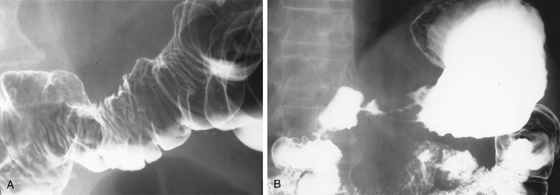CASE 119

History: A 55-year-old man presents with 2 months of anorexia, nausea, vomiting, and stool test positive for blood.
1. Which of the following should be included in the differential diagnosis of the imaging finding shown in Figure A? (Choose all that apply.)
A. Metastatic pancreatic malignancy
B. Metastatic gastric malignancy
2. What is the specific component of the omentum that allows spread of cancer from the stomach to the transverse colon?
3. What is the most common tumor of the omentum?
4. Which of the following is the most common finding on physical examination indicating metastatic gastric cancer?
ANSWERS
CASE 119
Spread of Gastric Carcinoma to the Colon via the Gastrocolic Ligament
1. A, B, C, and E
2. C
3. D
4. B
References
Meyers MA, Oliphant M, Berne AS, Feldberg MAM. The peritoneal ligaments and mesenteries: pathways of intraabdominal spread of disease. Radiology. 1987;163:593–604.
Sompayrac SW, Mindelzun RE, Silverman PM, Sze R. The greater omentum. Am J Roentgenol. 1997;168:683.
Cross-Reference
Gastrointestinal Imaging: THE REQUISITES, 3rd ed, p 290.
Comment
The “police officer” of the abdomen, the greater omentum (mostly made up of the gastrocolic ligament), encloses the lesser sac anteriorly; the posterior margin is the transverse mesocolon. A small connection between the lesser sac and the peritoneal cavity is located in the region of the duodenum, the epiploic foramen or foramen of Winslow. Processes affecting the lesser curvature of the stomach are therefore able to reach the transverse colon via the gastrocolic ligament, and it would manifest as serosal involvement along the course of the transverse colon, giving the characteristic crenulated margin, as seen in the barium image (see figures).
Peritoneal spread via lymphatics and drop metastases are more common than spread down the gastrocolic ligament. However, there are reports of metastatic disease to the stomach (i.e., melanoma) as well as primary gallbladder carcinoma spreading to the colon via the gastrocolic ligament. However, these are rare, and the first consideration should be the stomach (see figures).
Worldwide, gastric carcinoma is said to be the second most common malignancy after lung cancer, but there has been a significant drop in the incidence in the Western world since the 1980s. In general, the long-accepted “pathway” theory—chronic gastritis, diminished acidity, gastric atrophy, metaplasia, dysplasia, and cancer—is still considered valid. But the pathway may be influenced by several other factors such as Helicobacter pylori infection, dietary habits (smoked foods), and of course, long-term cigarette smoking.







